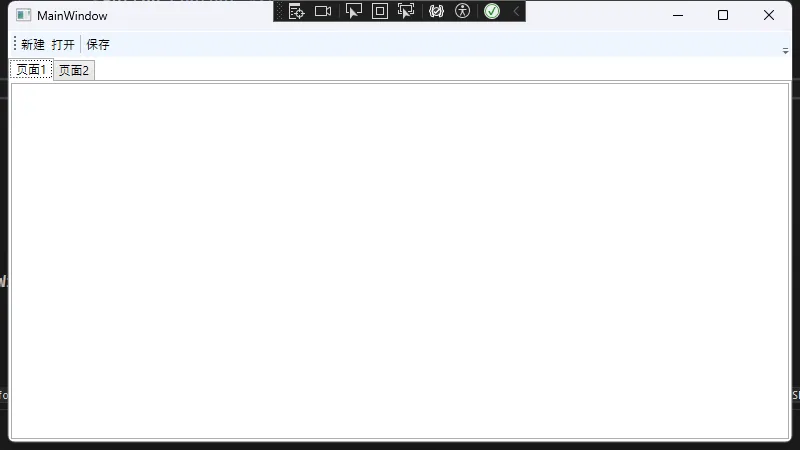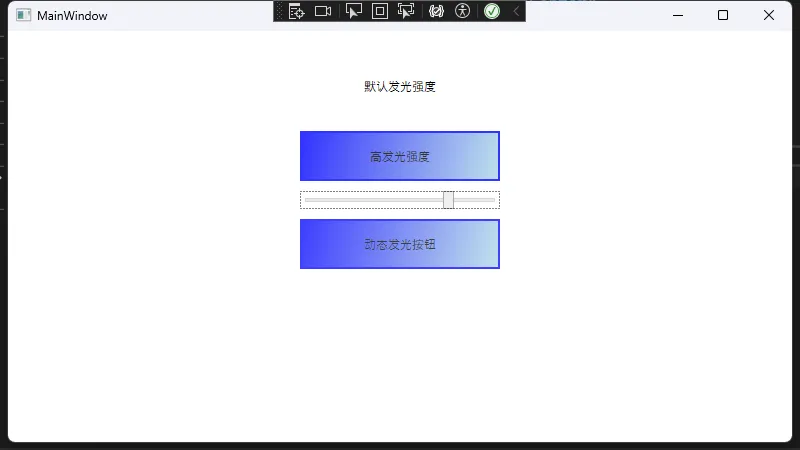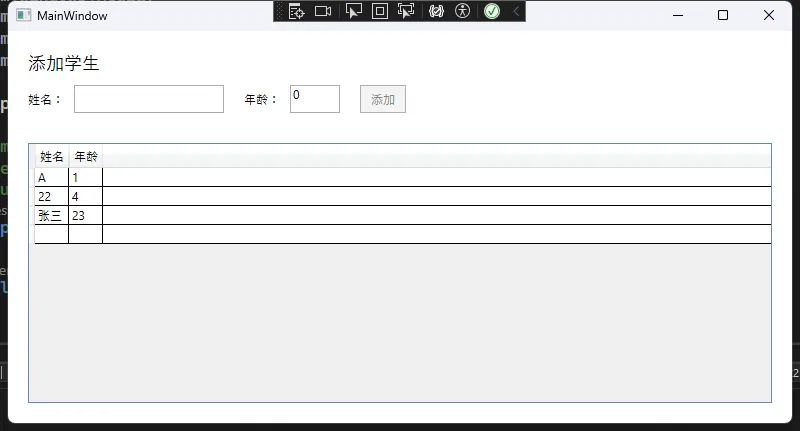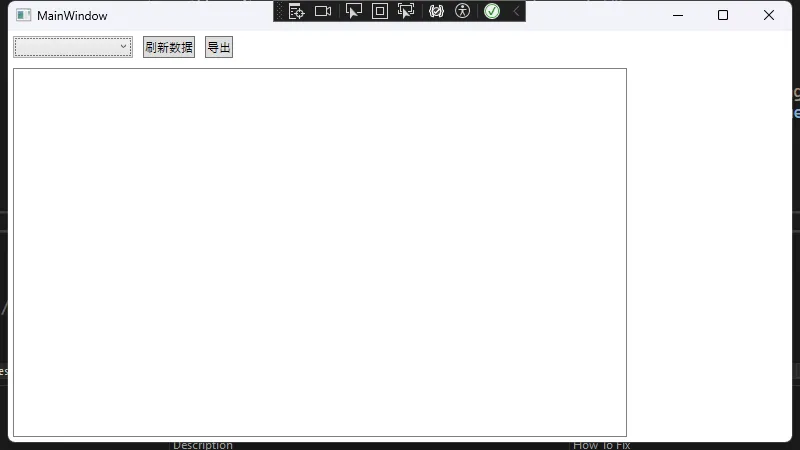请注意,本文编写于 189 天前,最后修改于 189 天前,其中某些信息可能已经过时。
目录
Windows Presentation Foundation (WPF) 是一个现代化的用户界面框架,专为构建 Windows 应用程序而设计。它通过分层的技术架构和丰富的功能集,提供了全面的应用程序开发解决方案。本文将探讨 WPF 的技术架构、核心优势以及一些示例代码,以帮助开发者更好地理解和应用这一框架,其实按我最浅显的理解,WPF更接近Web的一些应用技术,或者说更早的的一种实验。
技术架构
WPF 采用分层架构设计,主要包括以下几个层次:
XAML(可扩展应用程序标记语言):WPF 的声明式 UI 语言,允许开发者以 XML 格式定义用户界面。XAML 使得界面开发更加直观和高效。
XML<Grid>
<Grid.RowDefinitions>
<RowDefinition Height="Auto"/>
<RowDefinition Height="*"/>
</Grid.RowDefinitions>
<ToolBar Grid.Row="0">
<Button Content="新建" />
<Button Content="打开" />
<Separator />
<Button Content="保存" />
</ToolBar>
<TabControl Grid.Row="1">
<TabItem Header="页面1">
<TextBox AcceptsReturn="True" />
</TabItem>
<TabItem Header="页面2">
<DataGrid AutoGenerateColumns="True" />
</TabItem>
</TabControl>
</Grid>

依赖属性:WPF 属性系统的核心,支持属性值计算、继承和动画。依赖属性使得属性的值可以通过数据绑定、样式和动画进行动态更新。
C#public class ColorfulButton : Button
{
// 定义依赖属性
public static readonly DependencyProperty GlowIntensityProperty =
DependencyProperty.Register(
"GlowIntensity", // 属性名称
typeof(double), // 属性类型
typeof(ColorfulButton), // 所有者类型
new PropertyMetadata(0.0, OnGlowIntensityChanged) // 默认值和回调
);
// CLR属性包装器
public double GlowIntensity
{
get { return (double)GetValue(GlowIntensityProperty); }
set { SetValue(GlowIntensityProperty, value); }
}
// 静态构造函数
static ColorfulButton()
{
// 设置默认样式
DefaultStyleKeyProperty.OverrideMetadata(
typeof(ColorfulButton),
new FrameworkPropertyMetadata(typeof(ColorfulButton))
);
}
// 当属性值变化时的回调方法
private static void OnGlowIntensityChanged(DependencyObject d, DependencyPropertyChangedEventArgs e)
{
var button = d as ColorfulButton;
if (button != null)
{
// 创建一个渐变背景,根据发光强度调整透明度
var gradientBrush = new LinearGradientBrush
{
StartPoint = new Point(0, 0),
EndPoint = new Point(1, 1)
};
// 添加渐变色点
gradientBrush.GradientStops.Add(new GradientStop(Colors.Blue, 0));
gradientBrush.GradientStops.Add(new GradientStop(Colors.LightBlue, 1));
// 设置整体透明度
button.Background = gradientBrush;
button.Opacity = (double)e.NewValue;
// 添加一些额外的视觉效果
button.BorderBrush = Brushes.Blue;
button.BorderThickness = new Thickness(2);
}
}
}
XML<Window x:Class="App01.MainWindow"
xmlns="http://schemas.microsoft.com/winfx/2006/xaml/presentation"
xmlns:x="http://schemas.microsoft.com/winfx/2006/xaml"
xmlns:d="http://schemas.microsoft.com/expression/blend/2008"
xmlns:mc="http://schemas.openxmlformats.org/markup-compatibility/2006"
xmlns:local="clr-namespace:App01"
mc:Ignorable="d"
Title="MainWindow" Height="450" Width="800">
<Window.Resources>
<Style TargetType="{x:Type local:ColorfulButton}">
<Setter Property="Template">
<Setter.Value>
<ControlTemplate TargetType="{x:Type local:ColorfulButton}">
<Border Background="{TemplateBinding Background}"
BorderBrush="{TemplateBinding BorderBrush}"
BorderThickness="{TemplateBinding BorderThickness}">
<ContentPresenter
HorizontalAlignment="Center"
VerticalAlignment="Center"/>
</Border>
</ControlTemplate>
</Setter.Value>
</Setter>
</Style>
</Window.Resources>
<StackPanel Margin="20">
<local:ColorfulButton
Content="默认发光强度"
Width="200"
Height="50"
Margin="0,10"/>
<local:ColorfulButton
Content="高发光强度"
Width="200"
Height="50"
GlowIntensity="0.8"
Margin="0,10"/>
<Slider
Minimum="0"
Maximum="1"
Value="0.5"
Width="200"
x:Name="glowSlider"/>
<local:ColorfulButton
Content="动态发光按钮"
Width="200"
Height="50"
GlowIntensity="{Binding Value, ElementName=glowSlider}"
Margin="0,10"/>
</StackPanel>
</Window>

路由事件:WPF 支持事件隧道(Preview)和冒泡(Bubble),使得事件处理更加灵活。
MVVM(模型-视图-视图模型)模式:WPF 强调 MVVM 架构,促进了数据绑定和命令的使用,使得 UI 和业务逻辑的分离更加清晰。
C#public class Student : INotifyPropertyChanged
{
private string _name;
private int _age;
public string Name
{
get => _name;
set
{
if (_name != value)
{
_name = value;
OnPropertyChanged(nameof(Name));
}
}
}
public int Age
{
get => _age;
set
{
if (_age != value)
{
_age = value;
OnPropertyChanged(nameof(Age));
}
}
}
public event PropertyChangedEventHandler PropertyChanged;
protected virtual void OnPropertyChanged(string propertyName)
{
PropertyChanged?.Invoke(this, new PropertyChangedEventArgs(propertyName));
}
}
C#public class StudentViewModel : INotifyPropertyChanged
{
private Student _currentStudent;
public ObservableCollection<Student> Students { get; set; }
public Student CurrentStudent
{
get => _currentStudent;
set
{
_currentStudent = value;
OnPropertyChanged(nameof(CurrentStudent));
}
}
public ICommand AddStudentCommand { get; private set; }
public StudentViewModel()
{
Students = new ObservableCollection<Student>();
CurrentStudent = new Student();
AddStudentCommand = new RelayCommand(AddStudent, CanAddStudent);
}
private void AddStudent()
{
Students.Add(new Student
{
Name = CurrentStudent.Name,
Age = CurrentStudent.Age
});
CurrentStudent = new Student(); // 重置当前学生
}
private bool CanAddStudent()
{
return !string.IsNullOrWhiteSpace(CurrentStudent.Name) && CurrentStudent.Age > 0;
}
public event PropertyChangedEventHandler PropertyChanged;
protected virtual void OnPropertyChanged(string propertyName)
{
PropertyChanged?.Invoke(this, new PropertyChangedEventArgs(propertyName));
}
}
// 自定义命令接口实现
public class RelayCommand : ICommand
{
private readonly Action _execute;
private readonly Func<bool> _canExecute;
public RelayCommand(Action execute, Func<bool> canExecute = null)
{
_execute = execute ?? throw new ArgumentNullException(nameof(execute));
_canExecute = canExecute;
}
public event EventHandler CanExecuteChanged
{
add { CommandManager.RequerySuggested += value; }
remove { CommandManager.RequerySuggested -= value; }
}
public bool CanExecute(object parameter) => _canExecute == null || _canExecute();
public void Execute(object parameter) => _execute();
}
XML<Grid Margin="20">
<Grid.RowDefinitions>
<RowDefinition Height="Auto"/>
<RowDefinition Height="*"/>
</Grid.RowDefinitions>
<StackPanel Grid.Row="0" Margin="0,0,0,20">
<TextBlock Text="添加学生" FontSize="18" Margin="0,0,0,10"/>
<StackPanel Orientation="Horizontal" Margin="0,0,0,10">
<TextBlock Text="姓名:" VerticalAlignment="Center" Margin="0,0,10,0"/>
<TextBox Text="{Binding CurrentStudent.Name, UpdateSourceTrigger=PropertyChanged}"
Width="150" Margin="0,0,20,0"/>
<TextBlock Text="年龄:" VerticalAlignment="Center" Margin="0,0,10,0"/>
<TextBox Text="{Binding CurrentStudent.Age, UpdateSourceTrigger=PropertyChanged}"
Width="50"/>
<Button Content="添加"
Command="{Binding AddStudentCommand}"
Margin="20,0,0,0"
Padding="10,5"/>
</StackPanel>
</StackPanel>
<DataGrid Grid.Row="1"
ItemsSource="{Binding Students}"
AutoGenerateColumns="False">
<DataGrid.Columns>
<DataGridTextColumn Header="姓名" Binding="{Binding Name}"/>
<DataGridTextColumn Header="年龄" Binding="{Binding Age}"/>
</DataGrid.Columns>
</DataGrid>
</Grid>

WPF的核心优势
- 声明式 UI:通过 XAML,开发者可以以声明的方式定义用户界面,提升了开发效率和可读性。
- 灵活的布局系统:WPF 提供了多种布局控件(如 Grid、StackPanel、DockPanel 等),支持响应式设计,能够适应不同屏幕尺寸和分辨率。
- 强大的数据绑定机制:WPF 的数据绑定功能使得 UI 和数据模型之间的交互变得简单而高效,支持双向绑定和数据转换。
- 样式和模板系统:WPF 允许开发者通过样式和控制模板自定义控件的外观,提升了应用程序的可定制性。
- 基于 DirectX 的图形渲染:WPF 利用 DirectX 提供高性能的图形渲染,支持复杂的图形和动画效果。
示例:数据可视化应用
以下是一个简单的数据可视化示例,展示了如何使用 WPF 创建一个包含图表和控制面板的窗口。
XML<Window x:Class="WpfApp.DataVisualizationWindow"
xmlns="http://schemas.microsoft.com/winfx/2006/xaml/presentation"
Title="数据可视化示例">
<Grid>
<Grid.RowDefinitions>
<RowDefinition Height="Auto"/>
<RowDefinition Height="*"/>
</Grid.RowDefinitions>
<StackPanel Grid.Row="0" Orientation="Horizontal">
<ComboBox Width="120" Margin="5" ItemsSource="{Binding ChartTypes}" SelectedItem="{Binding SelectedChartType}"/>
<Button Content="刷新数据" Command="{Binding RefreshCommand}" Margin="5"/>
<Button Content="导出" Command="{Binding ExportCommand}" Margin="5"/>
</StackPanel>
<Grid Grid.Row="1">
<Grid.ColumnDefinitions>
<ColumnDefinition Width="*"/>
<ColumnDefinition Width="Auto"/>
</Grid.ColumnDefinitions>
<Border Grid.Column="0" BorderBrush="Gray" BorderThickness="1" Margin="5">
<Canvas x:Name="ChartCanvas">
<!-- 动态生成的图表内容 -->
</Canvas>
</Border>
<StackPanel Grid.Column="1" Width="150" Margin="5">
<ItemsControl ItemsSource="{Binding Legends}">
<ItemsControl.ItemTemplate>
<DataTemplate>
<StackPanel Orientation="Horizontal">
<Rectangle Width="16" Height="16" Fill="{Binding Color}" Margin="5"/>
<TextBlock Text="{Binding Name}" VerticalAlignment="Center"/>
</StackPanel>
</DataTemplate>
</ItemsControl.ItemTemplate>
</ItemsControl>
</StackPanel>
</Grid>
</Grid>
</Window>

结论
WPF 是一个功能强大的 UI 框架,凭借其分层架构和丰富的功能集,能够帮助开发者构建出既美观又高效的 Windows 应用程序。通过 XAML、依赖属性、MVVM 模式等特性,WPF 提供了灵活的开发方式,极大地提升了开发效率和应用质量。无论是企业级应用还是个人项目,WPF 都是一个值得考虑的选择。
本文作者:rick
本文链接:
版权声明:本博客所有文章除特别声明外,均采用 BY-NC-SA 许可协议。转载请注明出处!
目录